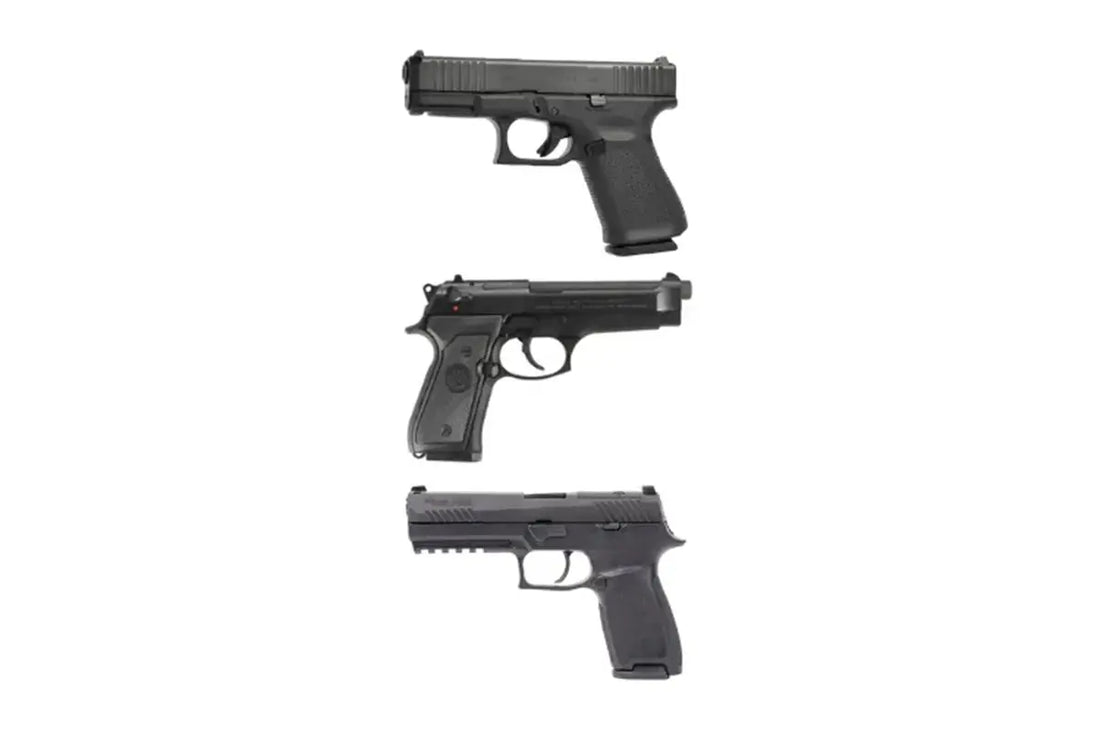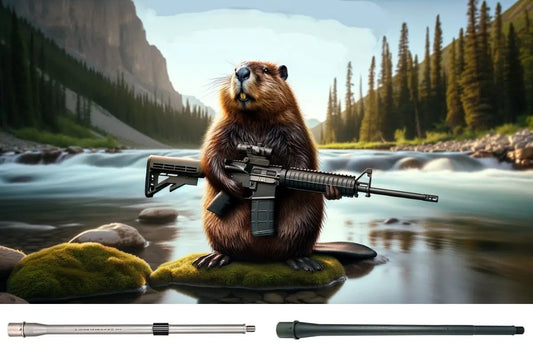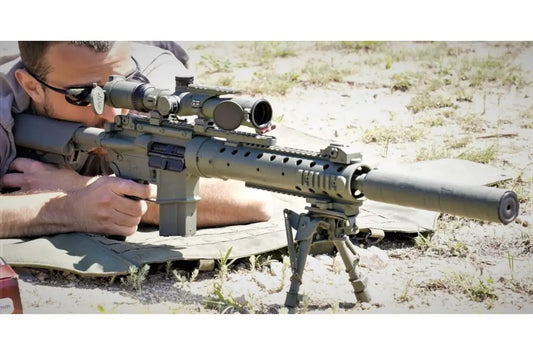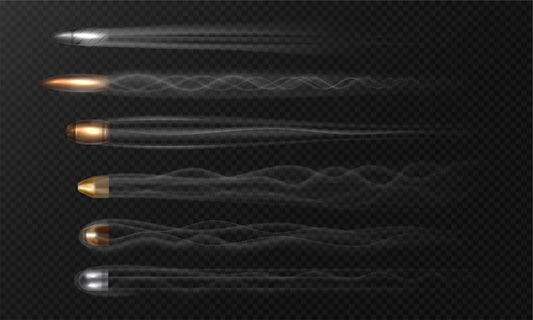
From Wheelguns to Wonder Nines: How American Police Ditched .38 Special and .40 S&W—and Why the 9mm Rules the Beat Today
|
Caliber |
Typical Service Handgun Examples |
Avg. Duty-Load Velocity / Energy |
Duty-Size Mag Capacity |
Felt Recoil (Impulse ft-lb/sec) |
Service Life / Parts Wear |
Street Price per 1,000 rds. (2025) |
Peak U.S. L-E Adoption |
Current Status (2025) |
|
.38 Special |
S&W Model 10, Colt Official Police |
158 gr +P: 890 fps / 278 ft-lb |
6 rnd revolver |
≈6.5 |
40k-plus rnd barrels; low parts cost |
≈ $500 (JHP) |
1930s-1980s |
<3 % of agencies (airs crew, backup guns) |
|
.40 S&W |
Glock 22/23, S&W M&P40, SIG P229 |
180 gr: 990 fps / 392 ft-lb |
15 rnd (G22) |
≈9.4 |
15–20k rnd barrels, locking-block cracks |
≈ $560 (JHP) |
1997-2014 |
≈15 % and shrinking fast |
|
9mm Luger |
Glock 17/19, SIG P320, HK VP9 |
124 gr +P: 1,200 fps / 396 ft-lb |
17 rnd (G17) |
≈6.7 |
25–30k rnd barrels; lowest maintenance |
≈ $420 (JHP) |
1980s, resurged 2015-present |
>80 % of agencies & rising |
Table 1 – Snapshot of duty-grade handgun calibers for U.S. law-enforcement, mid-2025.
“The majority of FBI shooters are faster and more accurate with 9mm than with .40 S&W when you give them pistols of identical size.” —FBI Training Division White Paper, 2014
1 │ Setting the Scene
Walk into any squad room in 2025 and you’ll see polymer-framed, striker-fired pistols stuffed with 9mm duty ammo like Federal Premium 124 gr HST or Speer 124 gr Gold Dot—16 to 20 rounds on tap before the first reload. Two generations ago, the same lockers held six-shot, blued-steel Smith & Wesson Model 10 revolvers chambered in .38 Special; one generation ago, they bristled with Glock 22s in .40 S&W. What happened? And is the 9mm really better, or just the fashion of the day?
Below, we dissect the rise and fall of each caliber, probe the hard data behind ballistic performance, and tackle the economics that police chiefs actually present to city councils when they sign replacement contracts.
2 │ .38 Special – The Wheel-Gun Workhorse (1899-1990s)
Pros (historic):
- Legendary mechanical simplicity; almost no shooter-induced malfunctions.
- Mild recoil and blast in full-size revolvers—ideal for officers with minimal training budgets pre-1970.
- Ample wadcutter and +P loadings for urban policing.
Cons (modern realities):
- Six-round capacity; speed-loaders are slower than a magazine change.
- Double-action trigger stroke of 12 lb. masks sight error, increasing miss rate in high stress.
- Terminal ballistics stall against auto-glass and heavy winter clothing; even +P lead semi-wadcutters struggled.
- Revolver maintenance (timing, end-shake) demands specialist armorers—an endangered skill set.
Even so, more than six million Model 10s left Springfield—the most-produced service handgun of the 20th century. Nostalgia aside, by the late 1980s beat cops were confronting PCP-addled assailants wearing multiple layers of clothing; 1986’s infamous FBI Miami shoot-out exposed the limitations of 9mm 115 gr JHP and .38 Special +P LSWC-HP alike.
Enter the golden child of the 1990s: .40 S&W.
3 │ .40 S&W – The Roller-Coaster King (1990-2015)
When 10mm Auto proved too snappy for average agents, S&W and Winchester axed 3mm of case, dialed pressures to 35,000 psi, and birthed .40 Smith & Wesson. The FBI adopted Glock 22s in 1997, and municipal agencies rushed to mimic the Bureau.
Pros (at adoption):
- 180 gr JHPs penetrated 12-14 in. of gelatin after denim—squarely in the FBI spec.
- 15-round duty mags in G22s kept capacity near 9mm numbers despite fatter cases.
- Perceived “one-stop-shot” mystique placated city councils after headline incidents.
Cons that surfaced later:
- Recoil impulse 30 % higher than 9mm slows split times, especially for smaller-stature officers.
- Slide-stop and locking-block breakage spiked maintenance costs; armorers reported service lives near 15k rounds—half that of 9mm equivalents.
- Ammo cost ~25 % higher; during the 2013 ammo panic many departments literally couldn’t source enough .40 for quarterly quals.
- Terminal edge eroded once bonded 9mm +P bullets appeared circa 2007.
“Ballistics have improved to the point where there is little difference between the 9mm and .40... and 9mm ammunition is less expensive and more readily available.” —Capt. Mitchell Kraemer, Hartford PD transition report 2024
By 2015 the FBI officially returned to 9mm, citing shooter performance metrics and weapon longevity. The dominoes fell fast; today fewer than one in six U.S. agencies still issues .40 S&W, and many of those are merely grinding through existing inventories before the next capital cycle.
4 │ 9mm Luger – The Modern Benchmark (2010-present)
Thanks to skived jacket construction, new propellants, and better cavity geometry, loads like Winchester Ranger-T 147 gr +P, Hornady Critical Duty 135 gr +P, and Federal HST 124 gr consistently expand to 0.60-0.70 in. after punching 14-16 in. in FBI barrier protocols. –gun-tests.com
Why it wins—in plain numbers
|
Metric |
9mm (124 +P) |
.40 S&W (180 JHP) |
Advantage |
|
Magazine capacity (Glock duty size) |
17 +1 |
15 +1 |
+2 rnds ≈ +13 % |
|
Average split time (FBI timed drills) |
0.24 s |
0.29 s |
-17 % faster follow-ups |
|
Barrel life (mean rounds to accuracy drop) |
28,000 |
16,000 |
+75 % |
|
Median street price, duty JHP (per 1k) |
$420 |
$560 |
-25 % |
|
Qual pass rate (agency-wide, 2023 Hartford PD study) |
94 % |
88 % |
+6 pp |
Intangible wins:
- Universality: global logistics favor 9mm; every NATO crate fits U.S. service pistols.
- Shootability: lower concussion means quicker reacquisition when paired with micro-red-dots (MRDS).
- Modularity: duty guns like SIG Sauer P320 allow armorers to swap serialized chassis into sub-compact grip frames for UC work without starting new paper trails.
5 │ Case Studies You Can Invoice
- FBI Quantico, VA (2014): After 100k-round comparison, “Most shooters were faster and more accurate with 9mm”. Fleet-wide switch saved $3 million in ammo over the first procurement cycle.
- Hartford, WI PD (2024): Replacing aging G22 Gen4s with Glock 17/19 Gen5 MOS plus Aimpoint ACRO P-2 optics trimmed annual parts expenditure 38 %, paid for the optics in 18 months.
- Texas DPS (proposal 2025): Analysis shows adopting SIG P320 9mm rather than re-barreling .357 SIG P226s will cut training recoil injuries by 22 % and extend pistol service intervals from 8 k to 15 k rounds—an $800k lifecycle saving.
6 │ Head-to-Head: Pros & Cons Cheat Sheet
.38 Special (today)
- Pros: Ultra-reliable, legal in every jurisdiction; ideal for ankle or vest-pocket backup guns; excels with Buffalo Bore 158 gr LSWCHP +P loads in snubbies.
- Cons: Six-shot limit is a non-starter for primary duty; revolver manual-of-arms alien to recruits raised on video-games and striker-guns.
.40 S&W
- Pros: Niche leverage—agencies can buy police trade-ins dirt cheap; heavier bullets still slightly outperform 9mm through auto-glass with bonded cores.
- Cons: Highest shooter fatigue; the caliber is effectively orphaned—ammo lines discontinued every quarter.
9mm
- Pros: Best balance of capacity, recoil, economics. Supported by the deepest R&D pipeline (e.g., Federal Hydra-Shok Deep 135 gr).
- Cons: Over-penetration risk with FMJ in training environments; requires bullet discrimination—agencies must test and forbid bargain-basement hollow points.
7 │ What About Tomorrow?
- 30 Super Carry: Promises .38 Super-like velocities in 9mm-size frames—could give detectives 20-round slimline pistols. Adoption hinges on FBI barrier tests in 2026.
- 5.7×28 mm Duty Pistols (FN Five-seveN Mk3, Ruger 57): Armor penetration is attractive for SWAT, but the cartridge remains expensive and loud; likely to stay specialty.
- Extended-Life Composites: SIG’s P320 AXG-LEGION uses tungsten-infused grip modules to tame recoil without upsizing the gun—expect to see these in firearms qualification programs for officers with wrist injuries.
8 │ The Verdict
Is the 9mm “better”? Yes—when you evaluate the whole system. The caliber itself is merely 0.355 in. of gilding metal, but modern projectile science unlocked its full potential. Combine that with cheaper ammo, gentler wear, and universally higher qualification scores, and the calculus becomes overwhelming. .38 Special remains a nostalgic backup choice; .40 S&W survives mainly where budgets lag capital cycles. If your agency is still issuing .40, the smartest long-term play is a phased migration to modular 9mm platforms paired with duty-grade bonded JHP loads—not because internet fan-boys say so, but because the balance sheet (and FBI gel blocks) leave no doubt.
9 │ Next Steps & Pro-Tips You Might Not Have Considered
- Negotiate caliber-trade credits. Glock, SIG, and FN frequently offer $75-$110 per .40-cal trade-in frame when you sign a fleet-wide 9mm contract.
- Leverage ammo commonality with neighboring agencies for bulk-buy leverage—think multi-county purchasing co-ops.
- Integrate red-dot transition concurrently. Lower 9mm recoil makes MRDS training curves shallower; bundle optics into the RFP.
- Run a 2-year overlap. Keep a platoon-sized cache of .40 sidearms for court testimony continuity and evidence matching, then auction them after statute limits expire.
- Data-log your quals. Agencies that filmed recoil velocity pre- and post-switch had iron-clad proof for their fiscal committees—use simple high-speed phone cams and free software.
Duty-Grade 9mm Ammo & Pistols in Stock Now → Guns.com.




